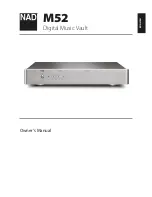
Dynamics
67
Digital Recording Console 02R User’s Guide
Gate and Ducking
A gate, or noise gate is an audio switch used to mute signals below a set
threshold level. It can be used to suppress background noise and hiss from
valve (tube) amps, effects pedals, and microphones.
Ducking is used to automatically reduce the levels of one signal when the
level of a source signal exceeds a specified threshold. It is used for
voice-over applications where, for example, level of background music is
automatically reduced, allowing an announcer to be heard clearly.
Gate (GAT) and Ducking (DUK) parameters:
Threshold
sets the level at which the gate closes, cutting off the signal.
Signals above the threshold level pass through unaffected. Signals at or
below the threshold cause the gate to close.
For ducking, trigger signal levels at and above the threshold level activate
ducking, and the signal level is reduced to a level set by the Range
parameter.
The trigger signal is determined using the KEY IN parameter.
Range
controls the level to which the gate closes. It can be used to reduce
the signal level rather than cut it completely. At a setting of –70 dB, the gate
closes completely when the input signal falls below the threshold. At a
setting of –30 dB, the gate only closes so far allowing an attenuated signal
through. At a setting of 0 dB, the gate has no effect. When signals are gated
abruptly, the sudden cut-off can sound odd.
For ducking, a setting of –70 dB causes the signal to be virtually cutoff. At a
setting of –30 dB the signal is ducked by 30 dB. At a setting of 0 dB, the
duck has no effect.
Attack
determines how fast the gate opens when the signal exceeds the
threshold level. Slow attack times can be used to remove the initial
transient edge of percussive sounds. Too slow an attack time makes some
signals sound backwards.
Parameter
Value
Threshold (dB)
–54 to 0
(55 points)
Range (dB)
–70 to 0
(71 points)
Attack (ms)
0 to 120
(121 points)
Hold (ms)
0.02 ms to 1.96s
*1
, 0.02 ms to 2.13 sec
*2
, 0.03 ms to
2.94 sec
*3
(216 points)
*1
These values are obtained when the sampling frequency is 48kHz.
*2
These values are obtained when the sampling frequency is 44.1 kHz.
*3
These values are obtained when the sampling frequency is 32 kHz
Decay (ms)
5ms to 42.3s *1, 6 ms to 46.0 sec*2,
8 ms to 63.4 sec *3
(160 points)
-70
-60
-50
-40
-30
-20
-10
0
+10
+20
-70
-60
-50
-40
-30
-20
-10
0
+10
+20
Input Level
Output Level
dB
dB
Threshold = -10dB
Range = -30dB
Range = -70dB
-70
-60
-50
-40
-30
-20
-10
0
+10
+20
-70
-60
-50
-40
-30
-20
-10
0
+10
+20
Input Level
Output Level
dB
dB
Range = -30dB
Threshold = -20dB
Summary of Contents for 02R
Page 1: ...DIGITAL RECORDING CONSOLE E...
Page 7: ...DIGITAL RECORDING CONSOLE User s Guide User s Guide...
Page 21: ...12 Introduction to the 02R Digital Recording Console 02R Getting Started Guide...
Page 27: ...18 Getting Started Digital Recording Console 02R Getting Started Guide...
Page 49: ...40 Introductory Recording Tutorial Digital Recording Console 02R Getting Started Guide...
Page 75: ...66 Secondary Recording Tutorial Digital Recording Console 02R Getting Started Guide...
Page 103: ...94 Index Digital Recording Console 02R Getting Started Guide...
Page 104: ...DIGITAL RECORDING CONSOLE Getting Started Guide Getting Started Guide...
Page 106: ...ii Sections Digital Recording Console 02R User s Guide...
Page 126: ...16 Controls and Connections Digital Recording Console 02R User s Guide...
Page 192: ...82 Dynamics Digital Recording Console 02R User s Guide...
Page 222: ...112 Internal Effects Digital Recording Console 02R User s Guide...
Page 232: ...122 Scene Memories Digital Recording Console 02R User s Guide...
Page 262: ...152 Groups and Pairs Digital Recording Console 02R User s Guide...
Page 335: ...224 Specifications Digital Recording Console 02R User s Guide...
Page 343: ...232 Glossary Digital Recording Console 02R User s Guide...
















































